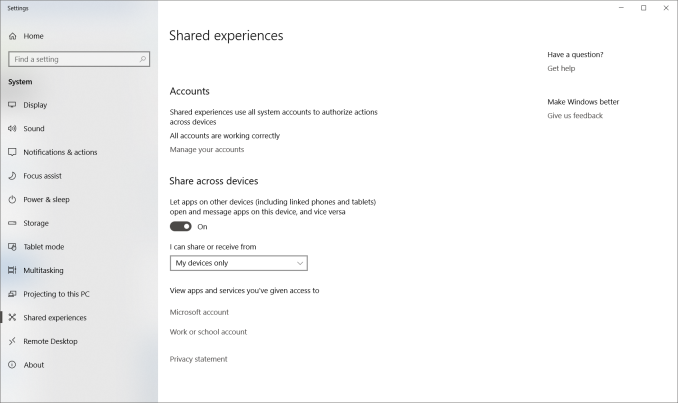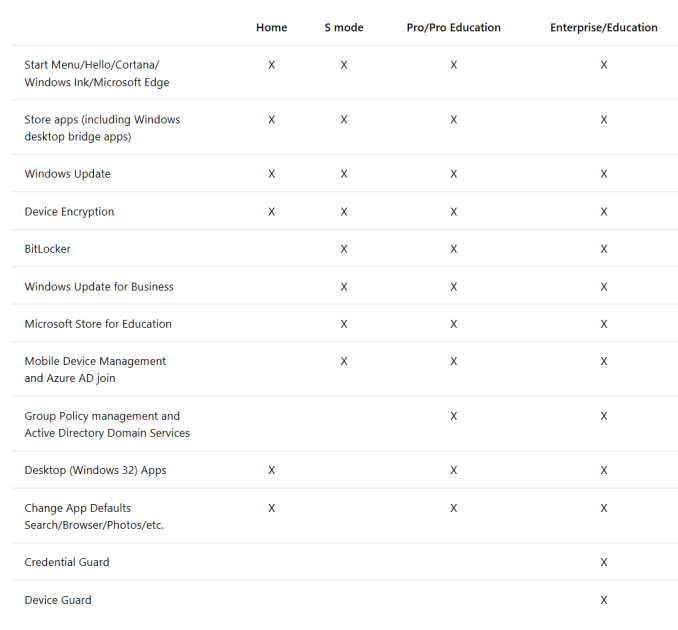The Windows 10 April Update (1803): The Littlest Big Update
by Brett Howse on May 25, 2018 8:00 AM EST- Posted in
- Software
- Operating Systems
- Windows
- Microsoft
- Windows 10
Nearby Share
One feature that should be very useful to certain people is Nearby Share. This lets you quickly and easily share files between people from PC to PC, without having to send an email or use a messaging app as the transfer tool. Nearby Share works over Bluetooth or Wi-Fi, and will use Wi-Fi as the preference. In an office, this was something done via a USB drive most recently, but with wireless and Bluetooth in all modern laptops, it makes sense to leverage that to avoid a step.
It should be very useful in certain situations, and isn’t tied to an account so you can send to any nearby device. The receiver will have the option of accepting the file. It’s not on by default, but can be toggled on when needed. It’s definitely something you’d not want to leave on.
Easy Bluetooth
Windows 10 now supports a simpler Bluetooth pairing process for some devices which lets you pair devices with a single click. You’ll get a pop-up notification asking if you want to pair a device, and if you say yes, it’s all setup. Devices have to support this though, and ones that require PINs are not going to work with a single click setup.
Windows 10 S Mode
Windows 10 S launched with the Surface Laptop as its first device to offer the constrained version of Windows 10 that restricts users to only running apps from the Store. The idea was to keep people from harming themselves, and to keep performance levels where they should be, by not allowing people to just install whatever they want, and to keep apps in packages that allow for easy removal and less items running at startup. This is pretty much how any modern smartphone works of course, but the downside to it on Windows 10 was that the Microsoft Store is not known as one of the key selling features, so uptake and usuage of Windows 10 S had to be pretty small. With the April Update, this is replaced by Windows 10 in S Mode, which is just a setting that can be enabled on any PC to make it like Window 10 S was. It'll still likely never get used, but it's a much better solution than another version of the OS just for this purpose. There's reasons you'd want this of course - education being a great example - but the average consumer is choosing Windows for the legacy application support, so this new model is definitely the better way to handle it.
The drawback is that S Mode is a one-way setting at the moment. A machine can be set in S mode when imaged using an unattended.xml file and dism, but if it's set back to regular Windows 10, there's not a way to switch back and forth.












161 Comments
View All Comments
nico_mach - Friday, May 25, 2018 - link
They pretty much did? These are the best, most useful implementations of Linux on Windows I've seen, and they're only lacking server versions.If you mean, why don't they ship linux? Well, they kind of do on Azure. There's no real reason to do so as a consumer facing OS, unless you're suggesting Windows EdgeOS? Which is very clearly crossing the line into why-bother territory.
PeachNCream - Tuesday, May 29, 2018 - link
There's no value in running something other than a *nix kernel at this point. If they want to keep costs low in the OS development department, then its probably as good a time as any to make the transition. The open source community and Microsoft could further mutually benefit from working together as would software compatibility and cross-platform functionality. All of that can be relatively hidden from the end user by the OS UI so aside from the one-time cost of conversion, a cost they could absorb into pushing out Windows 11 -- something that they'll eventually have to do anyway given predominant market forces, I think staying on their current course is a misstep and a missed opportunity for the computing industry in general and Microsoft in specific.ChristopherFortineux - Friday, June 8, 2018 - link
Because linux will never be fully supported for everyday use and software across the board. They can run the kernel within Windows already.Kvaern1 - Friday, May 25, 2018 - link
"But, once it does start rolling out through Windows Update, there will be some new things to check out, so let’s take a look at some of them."Not sure what you mean here. My home PC got it through Windows Update on April 30th.
Brett Howse - Friday, May 25, 2018 - link
You had to manually check for updates for that to happen on the 30th. The auto rollout has been a lot less aggressive.ikjadoon - Friday, May 25, 2018 - link
The flip side is that I was checking for *other* updates (some minor security fixes), not 1803.Got my first blue screen ever in Windows 10 immediately after the update. Plus a host of other minor bugs (Chrome freezing, OEM partition assigned a drive letter, etc.).
I would’ve appreciated either the choice to install 1803 (but why can’t I take minor updates like everyone else?) or don’t allow it all thru the OS unless you use the Media Creation Tool.
I didn’t need to be a beta tester seemingly a month early.
Drazick - Friday, May 25, 2018 - link
I wish they gave us back the option to customize Windows on installation phase.I'd really want to install a minimal Windows.
I don't need all this bloatware. I want my system to be compact and efficient.
LazloPanaflex - Friday, May 25, 2018 - link
You want "minimal windows"? Then do yourself a favor and upgrade to Win 7.Here's my recent experience with 10 -- bought the in-laws a lower end Dell laptop with 10 pre-installed. Could not get their slightly older HP printer working, even with win 10 drivers from HP's website. Bought a Canon printer, same problem. Logitec speakers would not work correctly for some reason. And the coup de grace? Windows updates refused to download. So I put Win 7 on it, and it's running great.
Microsoft can shove 10 up their collective asses.
Drazick - Friday, May 25, 2018 - link
Actually Windows 10 has smaller footprint than Windows 7 and it is more efficient.But still there are som many applications and background processes I don't want / need.
I wish I could not have them at all.
BurntMyBacon - Tuesday, May 29, 2018 - link
As far as space goes, I agree. Also faster boot time. More efficient in general operation is not so clear. As you said, so many applications and background processes.